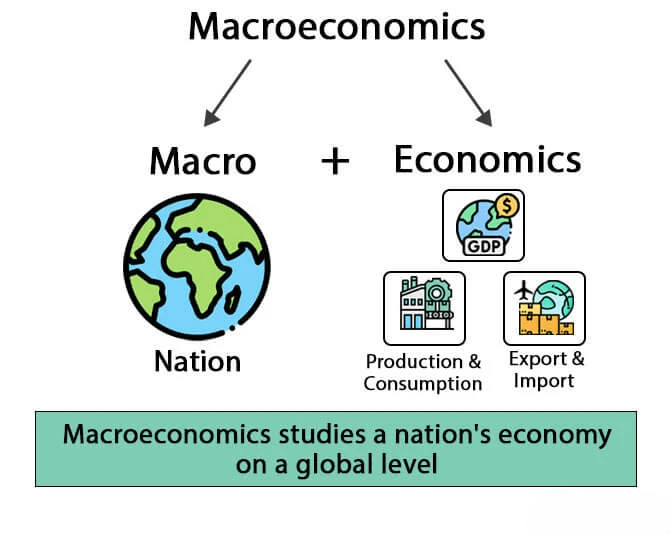
- Introduction
- Definition of Microeconomics
- Definition of Macroeconomics
- Key Differences
- Importance in Business
- Scope of Each Field
- Real-life Examples
- Tools and Techniques Used
- Impact on Government Policy
- Relevance in MBA
- Similarities
- Conclusion
Introduction
Economics as a discipline studies how individuals, businesses, and governments make decisions about the allocation of scarce resources. It is broadly classified into two main branches: microeconomics and macroeconomics. While they are closely related and often overlap in their principles and applications, they differ significantly in scope, objectives, and approaches. Microeconomics focuses on individual units such as consumers and firms, whereas macroeconomics examines the economy as a whole. Understanding both fields is essential for anyone studying business, policy-making, or pursuing a career in economics or management.
To Explore PMP in Depth, Check Out Our Comprehensive PMP Certification Training To Gain Insights From Our Experts!
Definition of Microeconomics
Microeconomics is the branch of economics that studies the behavior and decisions of individual units, such as households, firms, and industries. It analyzes how these entities interact in specific markets, how prices are determined, and how resources are allocated.

Key concepts in microeconomics include demand and supply, elasticity, marginal utility, production and cost theories, and market structures like monopoly, oligopoly, and perfect competition. Microeconomics seeks to understand the mechanisms of price formation and consumer behavior and how they influence the allocation of limited resources.
Definition of Macroeconomics
Macroeconomics, in contrast, deals with the economy at an aggregate level. It studies broad phenomena such as national income, total employment, inflation, economic growth, fiscal and monetary policies, and international trade. Macroeconomics is concerned with indicators that represent the health of an economy as a whole, such as Gross Domestic Product (GDP), unemployment rates, inflation indices, and balance of payments. It aims to understand how the overall economy functions and how government policies can influence economic performance. The ultimate goal of macroeconomics is to achieve economic stability, full employment, and sustainable growth.
Key Differences
- The primary difference between microeconomics and macroeconomics lies in their focus areas. Microeconomics zooms into the small-scale aspects of the economy, like consumer preferences, pricing mechanisms, and individual firm behaviors. Macroeconomics, on the other hand, looks at the bigger picture, examining aggregated outcomes like national income and inflation.
- Another key difference lies in their tools and objectives. Microeconomics uses partial equilibrium analysis, studying individual markets while assuming other markets remain constant. Macroeconomics employs general equilibrium analysis, which considers the interrelationships among all sectors of the economy. While microeconomics seeks efficiency in resource allocation, macroeconomics focuses on economic stability and growth.
Importance in Business
Both microeconomics and macroeconomics are crucial for business decision-making. Microeconomics helps firms understand consumer behavior, set prices, and optimize production. It assists in evaluating market competition and determining the cost-effectiveness of resources. For example, knowledge of price elasticity can help a business decide whether to raise or lower prices. Macroeconomics, meanwhile, helps businesses anticipate broader economic trends and adapt accordingly. Understanding inflation, interest rates, and GDP growth helps firms make long-term investment decisions. For instance, a company may delay expansion if a recession is predicted, or it may stockpile inventory in anticipation of rising prices due to inflation.
Scope of Each Field
The scope of microeconomics includes:
- Demand and supply analysis
- Price determination
- Consumer and producer equilibrium
- Theory of production and cost
- Market structures
- Factor pricing (wages, rent, interest, profits)

The scope of macroeconomics includes:
- National income and output
- Employment and unemployment
- Inflation and deflation
- Economic growth and development
- Fiscal and monetary policy
- International trade and finance
While microeconomics is often considered the foundation of economic theory, macroeconomics builds on it to explore how the overall system behaves and responds to policy interventions.
Are You Considering Pursuing a Master’s Degree in PMP? Enroll in the PMP Masters Program Training Course Today!
Real-life Examples
In real life, microeconomic principles explain why consumers might switch from one brand to another due to a price change. For instance, if the price of Pepsi drops significantly below that of Coke, many consumers may switch, assuming both products are close substitutes. Similarly, firms may decide to enter or exit a market based on profit expectations, which are analyzed using microeconomic models. Macroeconomic principles are observed in broader economic events. For example, during the 2008 financial crisis, governments worldwide used macroeconomic tools like stimulus packages and interest rate cuts to stabilize their economies. Another example is how central banks use interest rate changes to control inflation, a key macroeconomic variable.
Are You Interested in Learning More About PMP? Sign Up For Our PMP Certification Training Today!
Tools and Techniques Used
Macroeconomics relies on:
- National income accounting
- Aggregate demand and supply models
- IS-LM (Investment Saving–Liquidity Preference Money Supply) framework
- AD-AS (Aggregate Demand–Aggregate Supply) model
- Phillips curve (relationship between inflation and unemployment)
- Keynesian and Classical economic models
Both branches use mathematical models and graphs extensively to illustrate economic theories and predict outcomes.
Impact on Government Policy
Microeconomic insights help governments design policies that promote competition, regulate monopolies, and ensure efficient resource use. Taxation policies, subsidies, and welfare programs are influenced by microeconomic studies. For instance, subsidies for agriculture or small businesses are based on micro-level analysis. Macroeconomic policies aim at stabilizing the economy through fiscal tools (government spending and taxation) and monetary tools (interest rates, money supply). During times of economic downturn, governments may increase public spending or cut taxes to boost demand. Central banks may reduce interest rates to encourage borrowing and investment. These actions are based on macroeconomic models that predict how such policies will affect GDP, inflation, and employment.Relevance in MBA
Microeconomics and macroeconomics form the foundation of many business-related subjects in MBA programs. Microeconomics is essential for courses like marketing, operations, and managerial economics. It helps students understand pricing strategies, market dynamics, and consumer behavior. Macroeconomics is equally relevant in finance, international business, and strategic management. Understanding economic indicators, fiscal policies, and global trade trends is vital for making informed business decisions. For instance, an MBA graduate working in corporate finance must analyze interest rate trends to advise on investment portfolios. Economics also enhances critical thinking and analytical skills, which are crucial for leadership and managerial roles. It empowers MBA students to evaluate complex business scenarios in the context of both micro and macroeconomic environments.
Similarities
- Despite their differences, microeconomics and macroeconomics share several similarities. Both are grounded in the basic economic problem of scarcity and aim to allocate resources efficiently. They use similar tools, such as mathematical models, graphs, and data analysis, to study economic behavior.
- Moreover, the two fields are interdependent. Micro-level behavior influences macroeconomic outcomes, and macroeconomic policies affect micro-level decisions. For instance, if interest rates rise (a macroeconomic decision), consumers may reduce spending, and firms may cut back on investment (microeconomic reactions). Likewise, widespread firm-level decisions can influence national employment levels and GDP.
- Both fields also contribute to policy formulation, business strategy, and economic forecasting. They offer a structured approach to solving economic problems, whether on a small scale or at the national level.
Are You Preparing for PMP Jobs? Check Out ACTE’s Project Management Interview Questions & Answer to Boost Your Preparation!
Conclusion
Microeconomics and macroeconomics are two vital pillars of economics that offer different perspectives but ultimately work together to provide a comprehensive understanding of economic systems. Microeconomics focuses on the individual elements, helping us understand consumer choices, firm behavior, and market mechanisms. Macroeconomics looks at the broader picture, analyzing economic performance, government policy, and global trends. Both are indispensable in business, policy-making, and academic studies. Their combined insights enable better decision-making, efficient resource allocation, and strategic planning. For MBA students, mastering both fields is essential to navigate complex business environments and become effective leaders. Understanding the interplay between micro and macro forces prepares individuals to contribute meaningfully to economic development and organizational success.





